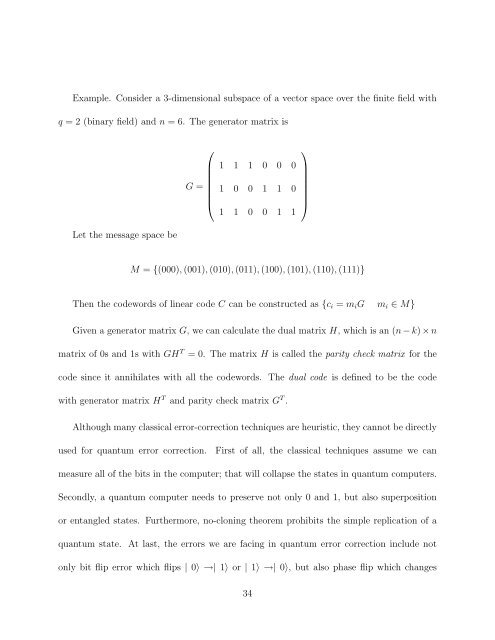t b a b a
t b a b a
t b a b a
Create successful ePaper yourself
Turn your PDF publications into a flip-book with our unique Google optimized e-Paper software.
Example. Consider a 3-dimensional subspace of a vector space over the finite field with<br />
q = 2 (binary field) and n = 6. The generator matrix is<br />
Let the message space be<br />
⎛<br />
⎞<br />
⎜<br />
G = ⎜<br />
⎝<br />
1<br />
1<br />
1<br />
0<br />
1<br />
0<br />
0<br />
1<br />
0<br />
1<br />
0 ⎟<br />
0<br />
⎟<br />
⎠<br />
1 1 0 0 1 1<br />
M = {(000), (001), (010), (011), (100), (101), (110), (111)}<br />
Then the codewords of linear code C can be constructed as {ci = miG mi ∈ M}<br />
Given a generator matrix G, we can calculate the dual matrix H, which is an (n − k) × n<br />
matrix of 0s and 1s with GH T = 0. The matrix H is called the parity check matrix for the<br />
code since it annihilates with all the codewords. The dual code is defined to be the code<br />
with generator matrix H T and parity check matrix G T .<br />
Although many classical error-correction techniques are heuristic, they cannot be directly<br />
used for quantum error correction. First of all, the classical techniques assume we can<br />
measure all of the bits in the computer; that will collapse the states in quantum computers.<br />
Secondly, a quantum computer needs to preserve not only 0 and 1, but also superposition<br />
or entangled states. Furthermore, no-cloning theorem prohibits the simple replication of a<br />
quantum state. At last, the errors we are facing in quantum error correction include not<br />
only bit flip error which flips | 0〉 →| 1〉 or | 1〉 →| 0〉, but also phase flip which changes<br />
34

















